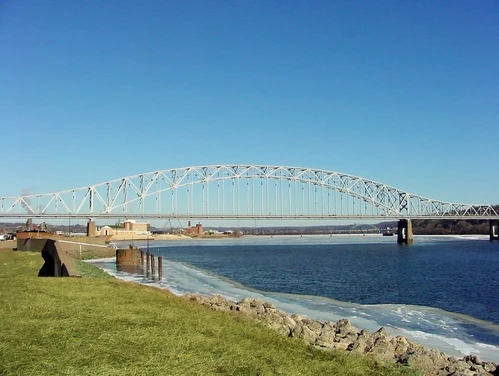- Year constructed: 1943
- Bridge type: Steel Cantilevered Tied Arch
- National Register of Historic Places status: Listed
- Length: 5760 feet
- Width: 29 feet
- Spans: 1
- FHWA: 023880
- Jurisdiction: Iowa DOT
- Location: U.S. 20 over the Mississippi River in Dubuque, Section 30, T89N-R3E (Julien Township)
Details
Named one of the top ten bridges in the country by Road and Bridges Magazine in 2003, the Julien Dubuque bridge spanning the Mississippi River was built by Ned Ashton of Bethlehem Steel in 1943. The current span is the only the latest historic bridge connecting the city of Dubuque with the Illinois side of the Mississippi.
From the start, Dubuque's fortunes have been tied inexorably to the Mississippi River. Founded by lead miners in 1833, the settlement soon became a stopping point for boats that plied the river trade. But Dubuque almost immediately concerned itself with travel across the river as well. One of the first commercial businesses established in the fledgling town was a ferry operation on the river, founded by General George W. Jones. The wagon ferries contributed greatly to the commercial prosperity of Dubuque and influenced the town's physical development through the location of their terminals. But the city paid a premium for its single railroad ferry. "The interests of Dubuque and Northern Iowa suffered for many years in consequence of the lack of transportation facilities between Dunleith and Dubuque," a historian wrote in 1880. "The ferry which plied between these cities was in the hands of the Illinois Central Railroad Company, and it was charged that this medium of communication was not only a merciless monopoly, but inadequate to the purpose."
After years of promoting for a railroad bridge by various Dubuque citizen's groups, the Dubuque and Dunleith Bridge Company was formed in 1866. The company received a Congressional charter for the bridge that year--one of the first such bridge charters granted for the Mississippi River. In January 1869, the company contracted with the Keystone Bridge Company of Philadelphia to build the original railroad bridge. Work on the first abutment began on January 27th; on December 15th the bridge was completed. The railroad bridge was renovated in 1900 and remains in operation today. The Dubuque Wagon Bridge opened in 1887 and was torn down in 1944 after the Julien Dubuque Bridge was completed in 1943. Two parts of the Railroad bridge were saved and used to build two county bridges, the White Water Creek Bridge, and the Cloie Bridge.
Julien Dubuque himself was an early Iowa pioneer, settling in what was then Spanish Louisiana in 1785. A fur-trader and lead-miner, Dubuque remained twenty years in northeastern Iowa, employing indigenous people and French Canadian settlers alike. He was buried on the top of a bluff overlooking the Mississippi River near Dubuque [adapted from Fraser 1993].
Areas Served
- Dubuque
